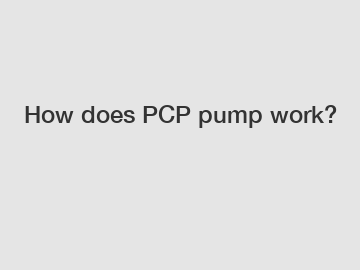How does PCP pump work?
Link to GX
How does PCP Pump Work?
Progressing cavity pump (PCP) is a type of positive displacement pump commonly used in various industries for efficient fluid transfer and handling. The PCP pump operates on a unique principle that enables it to handle a wide range of fluids, including viscous, abrasive, and even delicate substances. In this article, we will explore the working mechanism of a PCP pump and understand its significance in industrial applications.

PCP pump, also known as a helical rotor pump or a Moineau pump, consists of two essential components: a rotor and a stator. The rotor is typically a long, helical screw with a specific pitch, while the stator is a stationary tube with a matching helical cavity. These two components work in tandem to achieve fluid transfer.
1. Rotor-Stator Interaction:
The primary working principle of a PCP pump is the interaction between the rotor and the stator. As the rotor rotates within the stator, fluid enters the pump at the suction end. The helical rotor profile traps the fluid and progressively carries it towards the discharge end, reducing the volume of the cavity with each rotation.
2. Fluid Transfer and Sealing:
The interlocking action of the rotor and stator creates a series of sealed cavities that move from the suction end to the discharge end. As the rotor rotates, the volumetric reduction in each cavity causes the fluid to be pushed forward. Since the rotor and stator have a precise fit, this mechanism ensures a positive seal, preventing any backflow of the fluid.
3. Pressure Generation:
The reduction in cavity volume and the corresponding fluid displacement generates pressure within the pump. This pressure is responsible for propelling the fluid towards the discharge end. The flow rate of the pump is determined by the rotational speed of the rotor and the geometry of the rotor-stator pair.
4. Advantages of PCP Pump:
PCP pumps offer several advantages over other pumping technologies, making them popular in various industries. Some key advantages include:
- Ability to handle viscous and abrasive fluids: PCP pumps excel at handling highly viscous and abrasive fluids without clogging or excessive wear.
- Gentle handling of delicate substances: The gentle pumping action of PCP pumps makes them suitable for delicate substances that may be susceptible to degradation or damage during transfer.
- Self-priming capabilities: PCP pumps are self-priming, meaning they can draw fluids into the pump without the need for external priming.
- High efficiency: PCP pumps have high volumetric efficiencies, ensuring maximum fluid transfer with minimal energy consumption.
Closing:
In conclusion, the PCP pump operates on the principle of rotor-stator interaction to achieve efficient fluid transfer. Its ability to handle a wide range of fluids, including viscous and abrasive substances, makes it a valuable asset in various industries. Whether it is transferring fluids in oil and gas, wastewater management, or food processing, the PCP pump proves to be a reliable and versatile solution.
If you have any queries or require further information about PCP pumps, please do not hesitate to contact us. Our team of experts is readily available to assist you with your pumping needs.
For more information, please visit gx cs4 compressor.



